Research Trends and State of Knowledge of Decapod Crustaceans in Spain: A Bibliometric Analysis
Abstract
1. Introduction
2. Materials and Methods
3. Results and Discussion
3.1. Publications and Citations over Time
3.2. Numbers of Publications According to Type
3.3. Most Relevant Authors and Collaborative Networks
3.3.1. Author’s Production
3.3.2. Collaborative Network
3.3.3. Collaboration Countries
3.4. Geographical Distribution of Research in Spain
3.4.1. Species Studied
3.4.2. Research Analysis by Region
3.4.3. Most Productive Organizations
3.5. Journals
3.6. Trend Topic Analysis
3.6.1. Keywords
3.6.2. Trending Topics
4. Conclusions
Supplementary Materials
Author Contributions
Funding
Institutional Review Board Statement
Informed Consent Statement
Data Availability Statement
Acknowledgments
Conflicts of Interest
Abbreviations
| ALB | Alboran Sea |
| SWM | South Western Mediterranean |
| GC | Gulf of Cádiz |
| GB-GA | Gulf of Biscay-Galicia |
| CAN | Canary Islands |
| GEN | General (more than one sector involved) |
References
- De Grave, S.; Pentcheff, N.D.; Ahyong, S.T.; Chan, T.Y.; Crandall, K.A.; Dworschak, P.C.; Felder, D.L.; Feldmann, R.M.; Fransen, C.H.J.M.; Goulding, L.Y.D.; et al. A classification of living and fossil genera of decapod crustaceans. Raffles Bull. Zool. 2009, 21, 1–109. [Google Scholar]
- DecaNet Eds. DecaNet. Available online: https://www.decanet.info (accessed on 3 June 2025).
- Instituto Nacional de Estadística (INE). The Iberian Peninsula in Figures; INE: Madrid, Spain, 2023; pp. 1–90. ISSN 2182-8881. [Google Scholar]
- MAPA. Informe de Producto: Crustáceos; Ministerio de Agricultura, Pesca y Alimentación (MAPA); 2023. Available online: https://www.mapa.gob.es/es/ministerio/servicios/analisis-y-prospectiva/comercio-exterior/productos_pesqueros (accessed on 28 May 2025).
- Vázquez, J.M.; Urgorri, V.; Troncoso, J.S. El marisqueo en la cultura castreña de Galicia. In Galicia: Da Romanidade á Xermanización: Problemas Históricos e Culturais: Actas do Encontro Científico en Homenaxe a Fermín Bouza Brey (1901–1973); Museo do Pobo Galego: Santiago de Compostela, Spain, 1993; pp. 101–112. [Google Scholar]
- Ruiz-Cobo, J.; Muñoz-Fernández, E.; Bermejo-Castrillo, A.; Alonso-Sánchez, J.L.; Smith, P.; Crespo-Lastra, V. Prehistoria y Arqueología de la Cuenca del río Pas (Cantabria, España), 1st ed.; Publicaciones Electrónicas del Centro de Estudios Montañeses: Santander, Spain, 2020; Volume 15, pp. 1–402. [Google Scholar]
- Riera-Melis, A.R. Prehistoria y Arqueología de la Cuenca del río Pas (Cantabria, España), 1st ed.; Sociedad Española de Estudios Medievales: Madrid, Spain, 2009; pp. 121–144. [Google Scholar]
- Spanier, E.; Lavalli, K.L.; Goldstein, J.S.; Groeneveld, J.C.; Jordaan, G.L.; Jones, C.M.; Phillips, B.F.; Bianchini, M.L.; Kibler, R.D.; Díaz, D.; et al. A concise review of lobster utilization by worldwide human populations from prehistory to the modern era. ICES J. Mar. Sci. 2015, 72, i7–i21. [Google Scholar] [CrossRef]
- Bañón, R.; Irisarri, J. Historia del colapso de la pesquería de langosta Palinurus elephas (Fabricius, 1787) en Galicia: Lecciones para el presente. Bol. R. Soc. Esp. Hist. Nat. 2024, 118, 87–100. [Google Scholar] [CrossRef]
- Cornide, J. Ensayo de Una Historia de Los Peces y Otras Producciones Marinas de la Costa de Galicia; Edición Facsímil (1983); Estudio Preliminar por V. Paz-Andrade; Edición do Castro: A Coruña, Spain, 1788; pp. 1–263. [Google Scholar]
- De Buen, O. Materiales Para la Fauna Carcinológica de España; Anales de la Sociedad Española de Historia Natural: Madrid, Spain, 1887; Volume 16, pp. 405–434. [Google Scholar]
- Miranda y Rivera, A. Ensayo de un Catálogo de Los Crustáceos Decápodos Marinos de España y Marruecos Español; Dirección general de pesca: Madrid, Spain, 1933; pp. 1–72. [Google Scholar]
- Zariquiey, R. Crustáceos decápodos ibéricos. Invest. Pesq. 1968, 32, 1–510. [Google Scholar]
- Marco-Herrero, E.; Abelló, P.; Drake, P.; García-Raso, J.E.; González-Gordillo, J.E.; Guerao, G.; Palero, F.; Cuesta, J.A. Annotated checklist of brachyuran crabs (Crustacea: Decapoda) of the Iberian Peninsula (SW Europe). Sci. Mar. 2015, 79, 243–256. [Google Scholar] [CrossRef]
- García-Raso, J.E.; Cuesta, J.A.; Abelló, P.; Macpherson, E. Updating changes in the Iberian decapod crustacean fauna (excluding crabs) after 50 years. Sci. Mar. 2018, 82, 207–229. [Google Scholar] [CrossRef]
- Morales, X.; Bañón, R. Filo Arthropoda, Subfilo Crustacea. In Inventario de la Biodiversidad Marina de Galicia: Proyecto LEMGAL, 1st ed.; Bañón, R., Ed.; Consellería do Mar, Xunta de Galicia: Santiago de Compostela, Spain, 2018; pp. 433–444. [Google Scholar]
- Garcia-Socias, L.; Massuti, C. Inventari bibliográfic dels crustacis decápodes de les Balears (Crustacea Decapoda). Boll. Soc. Hist. Nat. Balears. 1987, 31, 67–92. [Google Scholar]
- Garcia-Socias, L.; Gràcia-Lladó, F. Nuevas aportaciones a la fauna de “Crustacea Decapoda” de las islas Baleares. Boll. Soc. Hist. Nat. Balears. 1988, 32, 47–56. [Google Scholar]
- González, J.A.; Espino, F.; González-Lorenzo, J.G. Changes in biogeographic patterns of coastal fishes: Indicators of tropicalization in the Canary Islands over the last 40 years. Mar. Environ. Res. 2025, 205, 107002. [Google Scholar] [CrossRef]
- Gonzalez-Perez, J.A. Catálogo de Los Crustáceos Decápodos de Las Islas Canarias, 1st ed.; Editorial Turquesa: Santa Cruz de Tenerife, Spain, 1995; pp. 1–273. [Google Scholar]
- González, J.A. Brachyuran crabs (Crustacea: Decapoda) from the Canary Islands (Eastern Atlantic): Checklist, zoogeographic considerations and conservation. Sci. Mar. 1996, 80, 89–102. [Google Scholar] [CrossRef]
- Costas, R.; Bordons, M. Desarrollo de un filtro temático para la delimitación bibliométrica de un área interdisciplinar: El caso de Ciencias del Mar. Rev. Esp. Doc. Cient. 2008, 31, 261–272. [Google Scholar] [CrossRef][Green Version]
- Borja, A.; Marques, J.C.; Olabarria, C.; Quintino, V. Marine research in the Iberian Peninsula: A pledge for better times after an economic crisis. J. Sea Res. 2013, 83, 1–8. [Google Scholar] [CrossRef]
- Muñoz-Mas, R.; Carrete, M.; Castro-Díez, P.; Delibes-Mateos, M.; Jaques, J.A.; López-Darias, M.; Nogales, M.; Pino, J.; Traveset, A.; Turon, X.; et al. Management of invasive alien species in Spain: A bibliometric review. NeoBiota 2021, 70, 123–150. [Google Scholar] [CrossRef]
- Veiga-del-Baño, J.M.; Cámara, M.Á.; Oliva, J.; Hernández-Cegarra, A.T.; Andreo-Martínez, P.; Motas, M. Mapping of emerging contaminants in coastal waters research: A bibliometric analysis of research output during 1986–2022. Mar. Pollut. Bull. 2023, 194, 115366. [Google Scholar] [CrossRef] [PubMed]
- Aguzzi, J.; Violino, S.; Costa, C.; Bahamon, N.; Navarro, J.; Chatzievangelou, D.; Robinson, N.J.; Doyle, J.; Martinelli, M.; Lordan, C.; et al. Established and emerging research trends in Norway lobster, Nephrops norvegicus. Biology 2023, 12, 225. [Google Scholar] [CrossRef]
- Echchakoui, S. Why and how to merge Scopus and Web of Science during bibliometric analysis: The case of sales force literature from 1912 to 2019. J. Market. Anal. 2020, 8, 165–184. [Google Scholar] [CrossRef]
- Sánchez, A.; del Río, M.C.; Álvarez, J. Bibliometric analysis of publications on wine tourism in the databases Scopus and WoS. Eur. Res. Manag. Bus. Econ. 2017, 23, 8–15. [Google Scholar] [CrossRef]
- Aria, M.; Cuccurullo, C. Bibliometrix: An R-tool for comprehensive science mapping analysis. J. Informetr. 2017, 11, 959–975. [Google Scholar] [CrossRef]
- van Eck, N.J.; Waltman, L. Software survey: VOSviewer, a computer program for bibliometric mapping. Scientometrics 2010, 84, 523–538. [Google Scholar] [CrossRef]
- Almón, B.; García-Raso, J.E.; Cuesta, J.A. A multilevel biodiversity approach of the hermit crabs in the Iberian Peninsula and ultraperipheral territories. Mar. Ecol. 2025, 46, e70011. [Google Scholar] [CrossRef]
- Zariquiey, R. Crustáceos decápodos mediterráneos: Manual para la clasificación de las especies que pueden capturarse en las costas mediterráneas españolas. Publ. Biol. Mar. Mediterr. 1946, 2, 1–181. [Google Scholar]
- Anadón, R. Aportación al conocimiento de la fauna bentónica de la ría de Vigo (NW de España). I. Pycnogónidos y crustáceos de Panjón. Inv. Pesq. 1975, 39, 199–218. [Google Scholar]
- Anger, K.; Urzúa, Á. Evolutionary transitions of decapod crustaceans to non-marine, polar, and deep-sea environments: Developmental, physiological and biochemical adaptations. Crustaceana 2024, 97, 1115–1133. [Google Scholar] [CrossRef]
- Alonso-Allende, J.M. Distribución de la cigala (Nephrops norvegicus) (decapoda, Reptantia) en las costas de Galicia. Inv. Pesq. 1980, 44, 347–360. [Google Scholar]
- Sardà, F.; Demestre, M. Estudio biológico de la gamba Aristeus antennatus (Risso 1816) en el Mar Catalán (NE de España). Inv. Pesq. 1987, 51, 213–232. [Google Scholar]
- González-Gurriarán, E. Introducción al estudio de una población de Macropipus puber (L.) (Decapoda-Brachyura), en la ría de Arosa (Galicia-España). Bol. Inst. Esp. Oceanogr. 1978, 4, 71–80. [Google Scholar]
- González-Gurriarán, E.; Freire, J. Movement patterns and habitat utilization in the spider crab Maja squinado (Herbst) (Decapoda, Majidae) measured by ultrasonic telemetry. J. Exp. Mar. Biol. Ecol. 1994, 184, 269–291. [Google Scholar] [CrossRef]
- Lifjeld, J.T. When taxonomy meets genomics: Lessons from a common songbird. Mol. Ecol. 2015, 24, 2901–2903. [Google Scholar] [CrossRef][Green Version]
- García-Munoz, J.E.; Cuesta, J.A.; García-Raso, J.E. Taxonomic study of the Pagurus forbesii “complex” (Crustacea: Decapoda: Paguridae): Description of Pagurus pseudosculptimanus sp. nov. from Alborán Sea (Southern Spain, Western Mediterranean Sea). Zootaxa 2014, 3753, 25–46. [Google Scholar] [CrossRef]
- Weiss, R.; Torrecilla, Z.; González-Ortegón, E.; González-Tizón, A.M.; Martínez-Lage, A.; Schubart, C.D. Genetic differentiation between Mediterranean and Atlantic populations of the common prawn Palaemon serratus (Crustacea: Palaemonidae) reveals uncommon phylogeographic break. J. Mar. Biol. Assoc. United Kingd. 2017, 98, 1425–1434. [Google Scholar] [CrossRef]
- Almón, B.; Cuesta, J.A.; García-Raso, J.E. Two new hermit crab species of Diogenes (Crustacea: Decapoda: Diogenidae) from Atlanto-Mediterranean coasts of the Iberian Peninsula: Poleward migrants or merely overlooked indigenous species? Ecol. Evol. 2022, 12, e8844. [Google Scholar] [CrossRef] [PubMed]
- Almón, B.; Cuesta, J.A.; Schubart, C.D.; Armenia, L.; García-Raso, J.E. Redescription of the hermit crab Diogenes pugilator (Decapoda: Anomura) reveals the existence of a species complex in the Atlanto-Mediterranean transition zone, resulting in the resurrection of D. curvimanus and the description of a new species. Zool. J. Linn. Soc. 2022, 195, 1116–1146. [Google Scholar] [CrossRef]
- González-Castellano, I.; González-López, J.; González-Tizón, A.M.; Martínez-Lage, A. Genetic diversity and population structure of the rockpool shrimp Palaemon elegans based on microsatellites: Evidence for a cryptic species and differentiation across the Atlantic-Mediterranean transition. Sci. Rep. 2020, 10, 10784. [Google Scholar] [CrossRef]
- Freire, J.; García-Allut, A. Socioeconomic and biological causes of management failures in European artisanal fisheries: The case of Galicia (NW Spain). Mar. Policy 2000, 24, 375–384. [Google Scholar] [CrossRef]
- González-Gurriarán, E.; Freire, J.; Bernárdez, C. Migratory patterns of female spider crabs Maja squinado detected using electronic tags and telemetry. J. Crustac. Biol. 2002, 22, 91–97. [Google Scholar] [CrossRef]
- Sampedro, M.P.; González-Gurriarán, E. Aggregating behaviour of the spider crab Maja squinado in shallow waters. J. Crustac. Biol. 2004, 24, 168–177. [Google Scholar] [CrossRef]
- Neumann, V. A review of the Maja squinado (Crustacea: Decapoda: Brachyura) species-complex with a key to the eastern Atlantic and Mediterranean species of the genus. J. Nat. Hist. 1998, 32, 1667–1684. [Google Scholar] [CrossRef]
- Balss, H. Crustacea VII: Decapoda Brachyura (Oxyrhyncha bis Brachyrhyncha) und geographische Übersicht über Crustacea Decapoda. In Beiträge zur Kenntnis der Meeresfauna Westafrikas. Band III, Lieferung 3; Michaelsen, W., Ed.; L. Friederichsen & Co.: Hamburg, Germany, 1922; pp. 72–110. [Google Scholar]
- Sotelo, G.; Morán, P.; Posada, D. Genetic identification of the northeastern Atlantic spiny spider crab Maja brachydactyla Balss, 1922. J. Crustac. Biol. 2008, 28, 76–81. [Google Scholar] [CrossRef]
- Su-Ching, C.; Tin-Yam, C. Multigene phylogeny of reef lobsters of the family Enoplometopidae (Decapoda: Crustacea). Invertebr. Syst. 2022, 36, 973–983. [Google Scholar] [CrossRef]
- García-Raso, E.; d’Udekem d’Acoz, C.; Moukrim, A.; Schubart, C.D.; Cuesta, J.A. A new cryptic species of Polybiidae (Crustacea: Decapoda: Portunoidea) from the East Atlantic, with considerations on the genus Polybius. Eur. J. Taxon. 2024, 930, 277–313. [Google Scholar] [CrossRef]
- Halisçelik, E.; Soytas, M.A. Sustainable development from millennium 2015 to Sustainable Development Goals 2030. Sustain. Dev. 2019, 27, 545–572. [Google Scholar] [CrossRef]
- Galil, B.S.; Clark, P.F.; Carlton, J.T. (Eds.) The Wrong Place—Alien Marine Crustaceans: Distribution, Biology and Impacts, 1st ed.; Springer: Dordrecht, Netherlands, 2011; pp. 1–714. [Google Scholar]
- Png-Gonzalez, L.; Comas-González, R.; Calvo-Manazza, M.; Follana-Berná, G.; Ballesteros, E.; Díaz-Tapia, P.; Falcón, J.M.; García Raso, J.E.; Gofas, S.; González-Porto, M.; et al. Updating the National Baseline of Non-Indigenous Species in Spanish Marine Waters. Diversity 2023, 15, 630. [Google Scholar] [CrossRef]
- Box, A.; Colomar, V.; Sureda, A.; Tejada, S.; Nuñez-Reyes, V.; Cohen-Sanchez, A.; Avila, T.; Forteza, V.; Castello, M.; Valverde, N.; et al. Next step of the colonization of the Balearic Islands (Spain) by invasive Atlantic blue crab, Callinectes sapidus Rathbun, 1896 (Crustacea: Decapoda: Portunidae). BioInvasions Rec. 2020, 9, 259–265. [Google Scholar] [CrossRef]
- García, L.; Pinya, S.; Colomar, V.; París, T.; Puig, M.; Rebassa, M.; Mayol, J. The first recorded occurrences of the invasive crab Callinectes sapidus Rathbun, 1896 (Crustacea: Decapoda: Portunidae) in coastal lagoons of the Balearic Islands (Spain). BioInvasions Rec. 2018, 7, 191–196. [Google Scholar] [CrossRef]
- Lameira, H.L.N.; Guerrero-Moreno, M.A.; da Silva, E.C.; Oliveira, F.A.; Teodósio, M.A.; Dias-Silva, K.; Moura, J.F., Jr.; Juen, L.; Oliveira-Junior, J.M.B. Citizen Science as a Monitoring Tool in Aquatic Ecology: Trends, Gaps, and Future Perspectives. Sustainability 2025, 17, 4972. [Google Scholar] [CrossRef]
- Otero, P.; Menéndez-Blázquez, J.; March, D. Challenges of passive citizen science in ecology within a shifting social media landscape. Ecol. Inform. 2025, 90, 103278. [Google Scholar] [CrossRef]
- Nassar, J.M.; Khan, S.M.; Velling, S.J.; Diaz-Gaxiola, A.; Shaikh, S.F.; Geraldi, N.R.; Torres, G.A.; Duarte, C.M.; Mussain, M.M. Compliant lightweight non-invasive standalone “Marine Skin” tagging system. NPJ Flex. Electron. 2018, 2, 13. [Google Scholar] [CrossRef]
- Hyungtaek, J.; Lyons, R.; Hurwood, D.; Mather, P. Genes and growth performance in crustacean species: A review of relevant genomic studies in crustaceans and other taxa. Rev. Aquacult. 2013, 5, 77–110. [Google Scholar] [CrossRef]
- Xiong, W.; Li, H.; Zhan, A. Early detection of invasive species in marine ecosystems using high-throughput sequencing: Technical challenges and possible solutions. Mar. Biol. 2016, 163, 139. [Google Scholar] [CrossRef]
- Le Joncour, A.; Mouchet, M.; Boussarie, G.; Lavialle, G.; Pennors, L.; Bouche, L.; Le Bourdonnec, P.; Morandeau, F.; Kopp, D. Is it worthy to use environmental DNA instead of scientific trawling or video survey to monitor taxa in soft-bottom habitats? Mar. Environ. Res. 2024, 200, 106667. [Google Scholar] [CrossRef]
- Piechaud, N.; Hunt, C.; Culverhouse, P.; Foster, N.; Howell, K.L. Automated identification of benthic epifauna with computer vision. Mar. Ecol. Progr. Ser. 2019, 615, 15–30. [Google Scholar] [CrossRef]
- Singh, R.; Mumbarekar, V. Neural network model approach for automated benthic animal identification. ICT Express 2022, 8, 640–645. [Google Scholar] [CrossRef]
- Trotter, C.; Griffiths, H.J.; Whittle, R.J. Surveying the deep: A review of computer vision in the benthos. Ecol. Inform. 2025, 86, 102989. [Google Scholar] [CrossRef]
- Teixeira, C.M.; Coelho, M.P.; Gil, M.M.; Pita, C.; Silva, P.M. Changing the way we look to fisheries’ discards. Reg. Stud. Mar. Sci. 2024, 71, 103434. [Google Scholar] [CrossRef]
- Gómez, S.; Maynou, F. Alternative seafood marketing systems foster transformative processes in Mediterranean fisheries. Mar. Policy 2021, 127, 104432. [Google Scholar] [CrossRef]
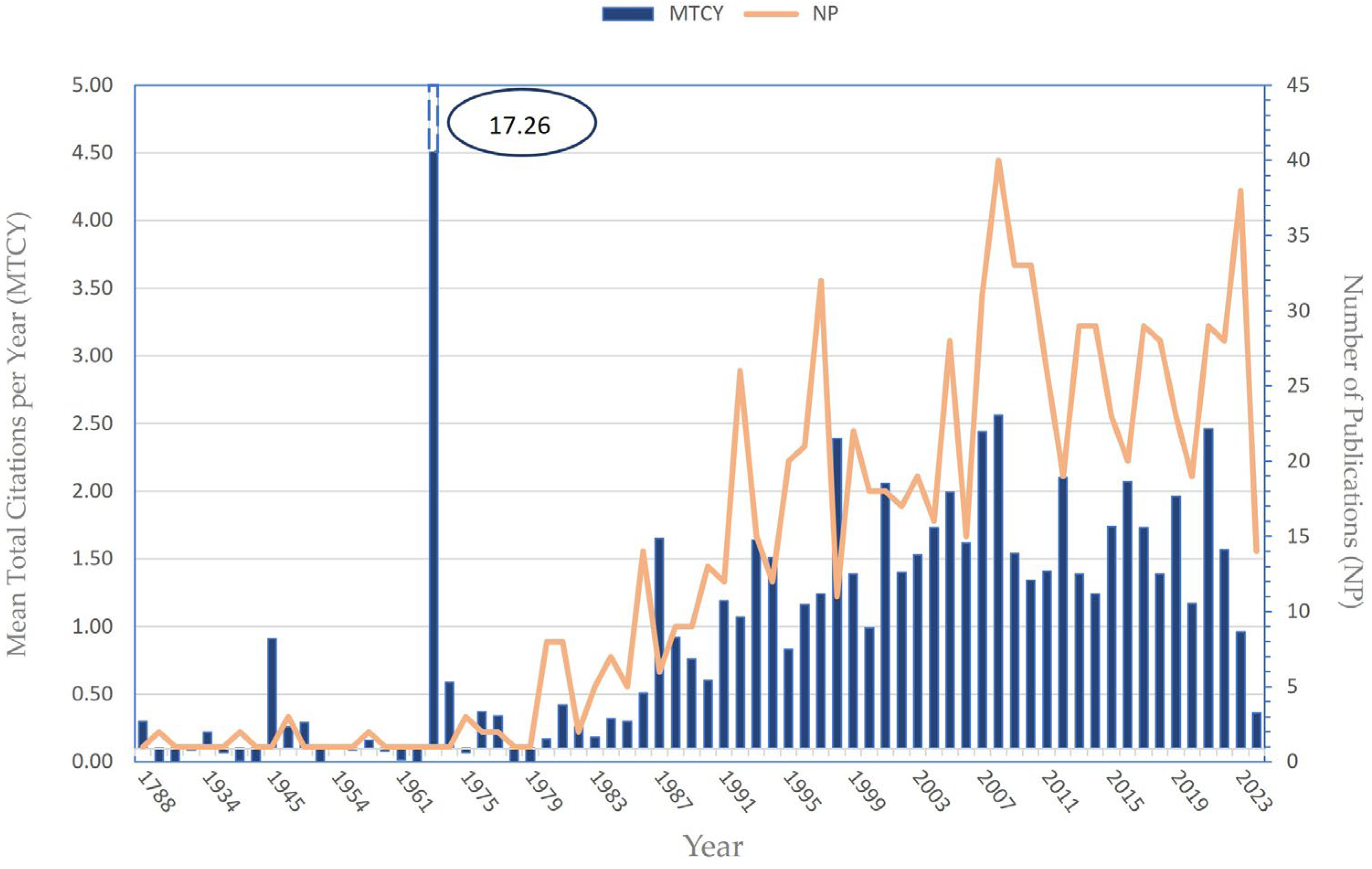
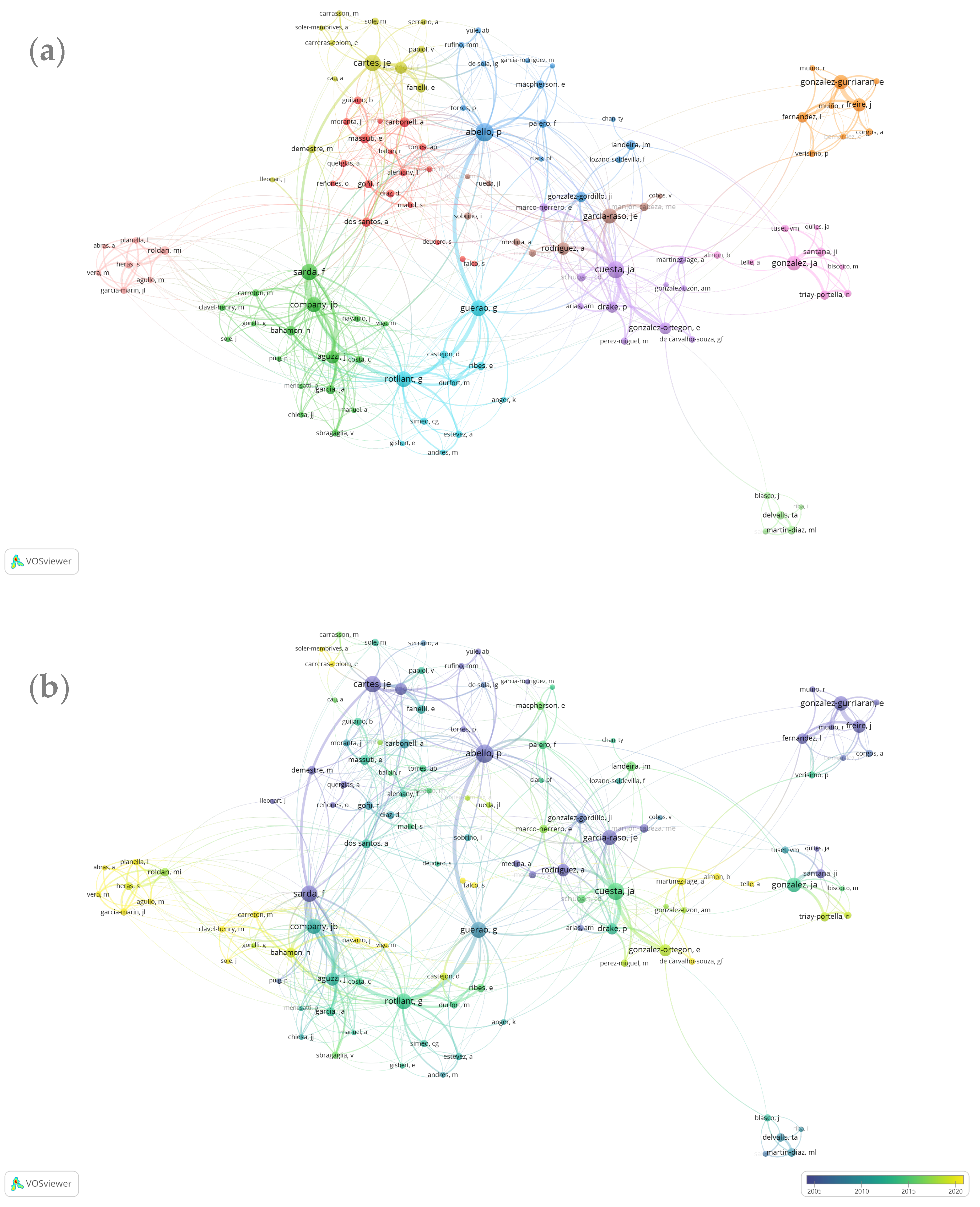
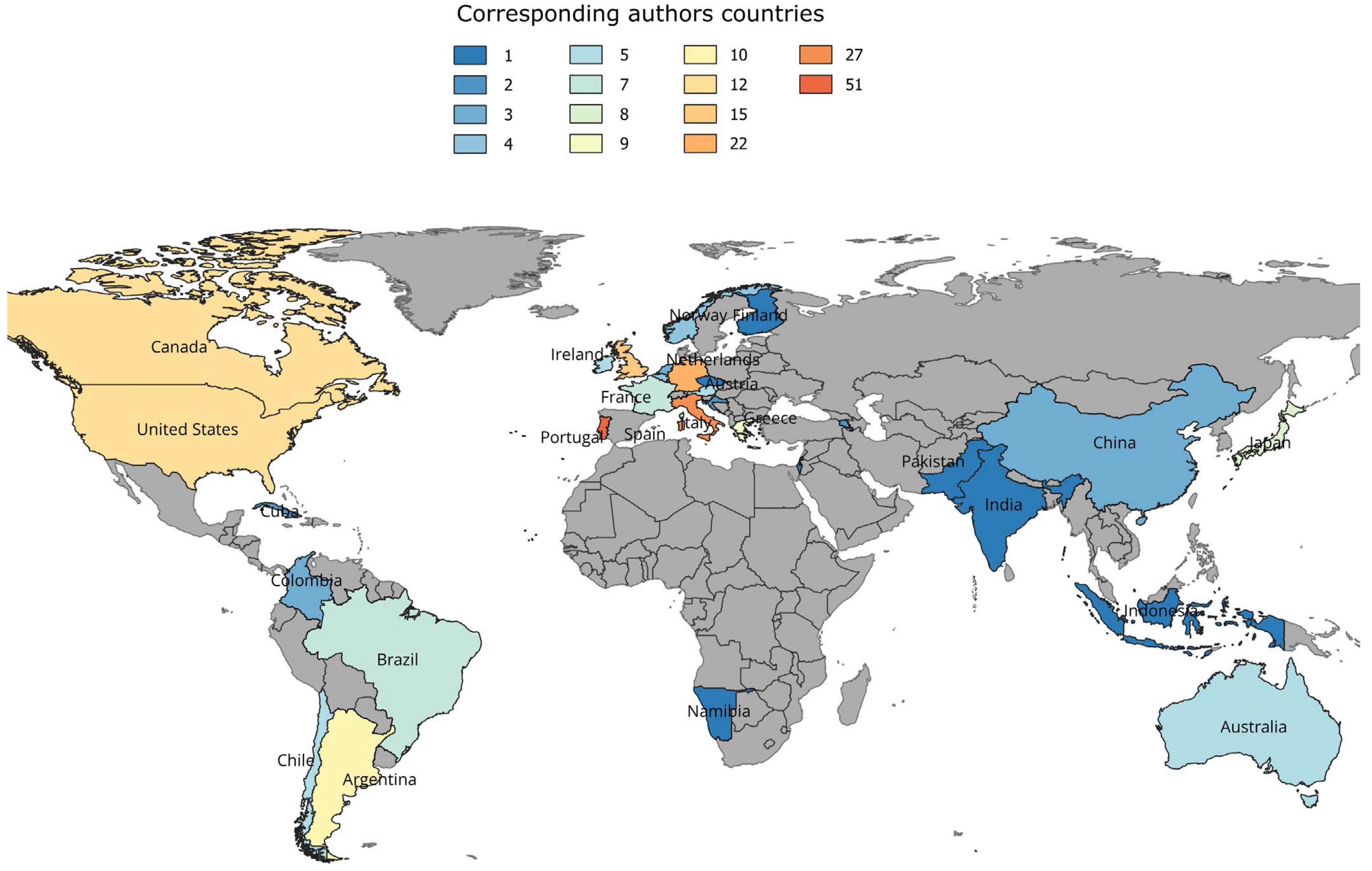
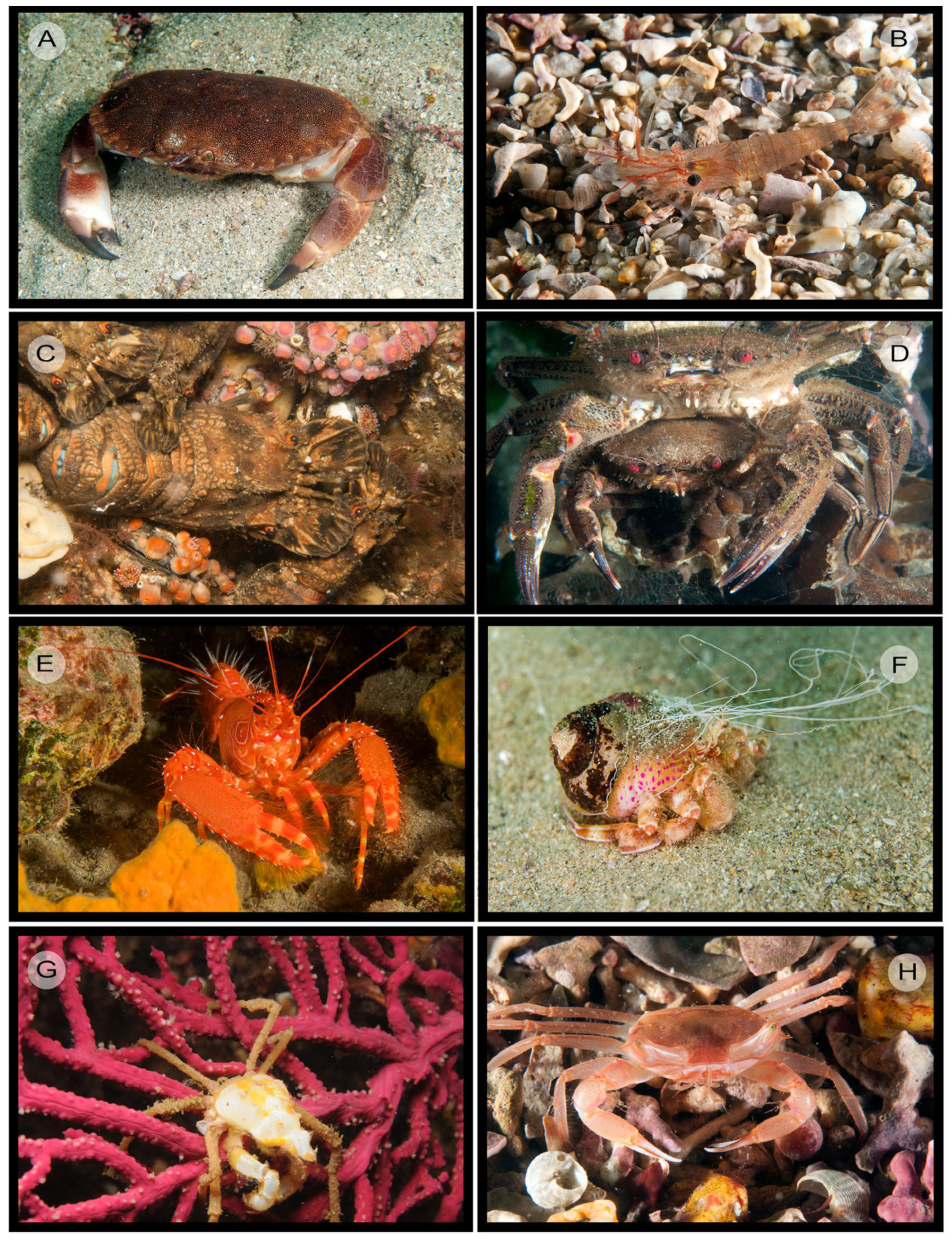
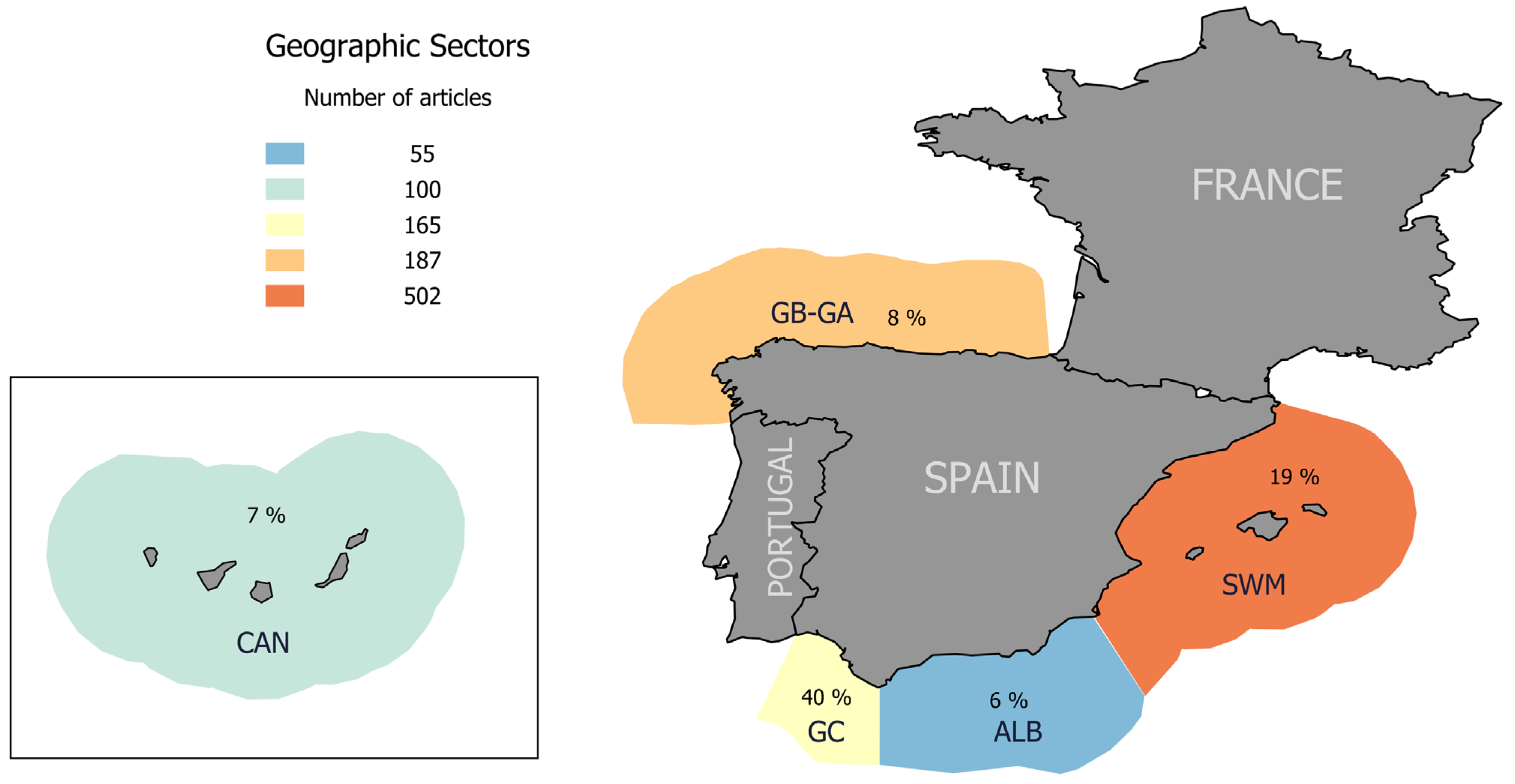
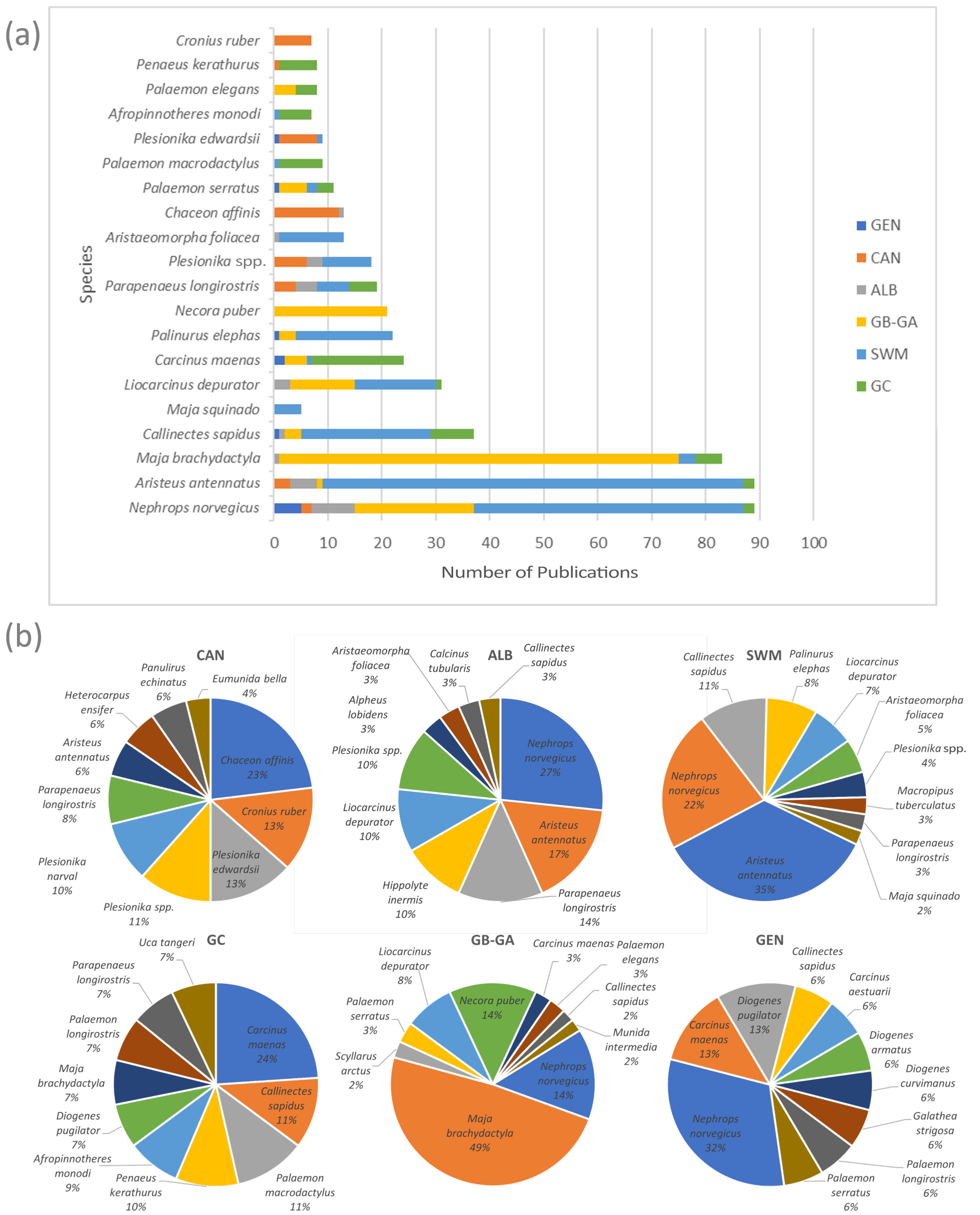
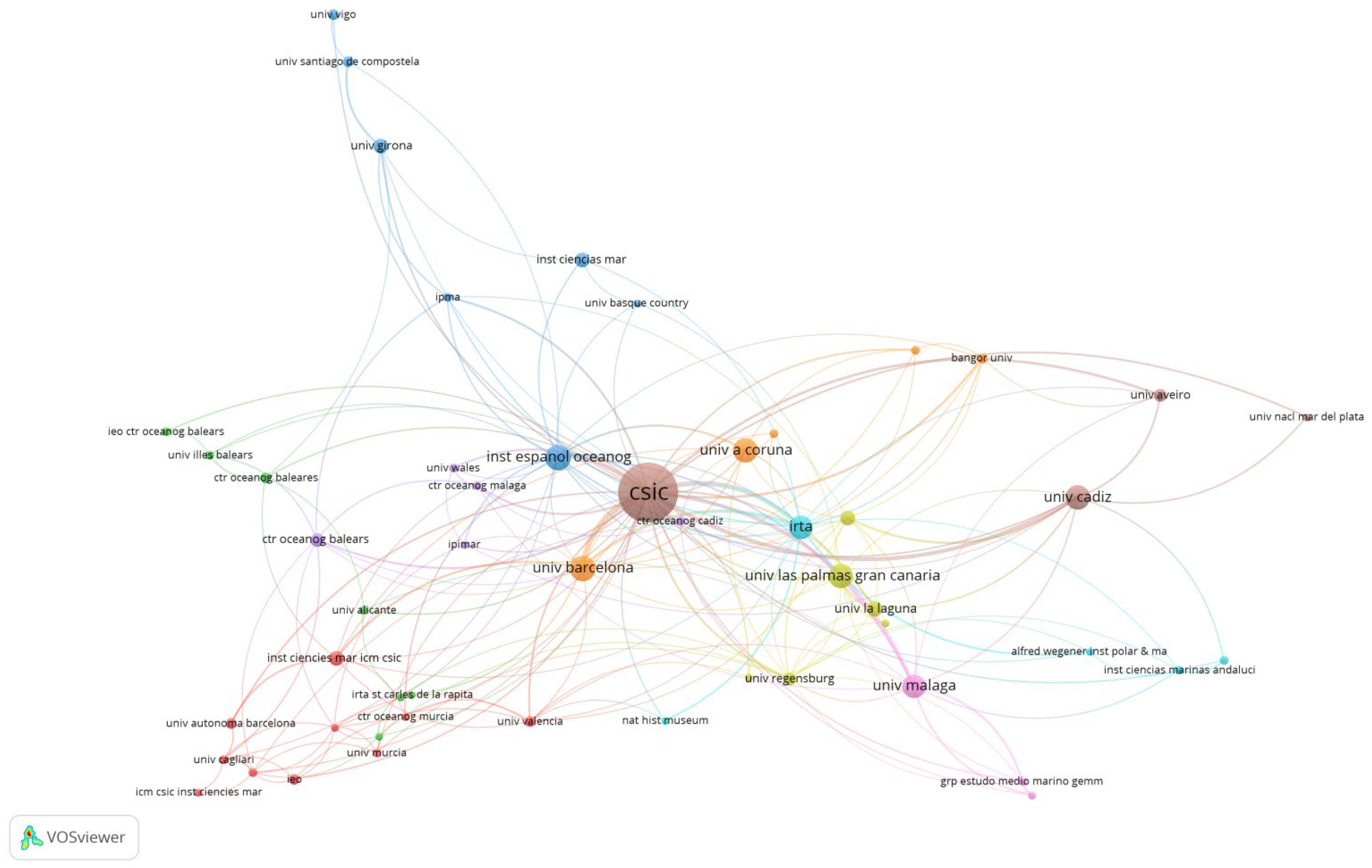
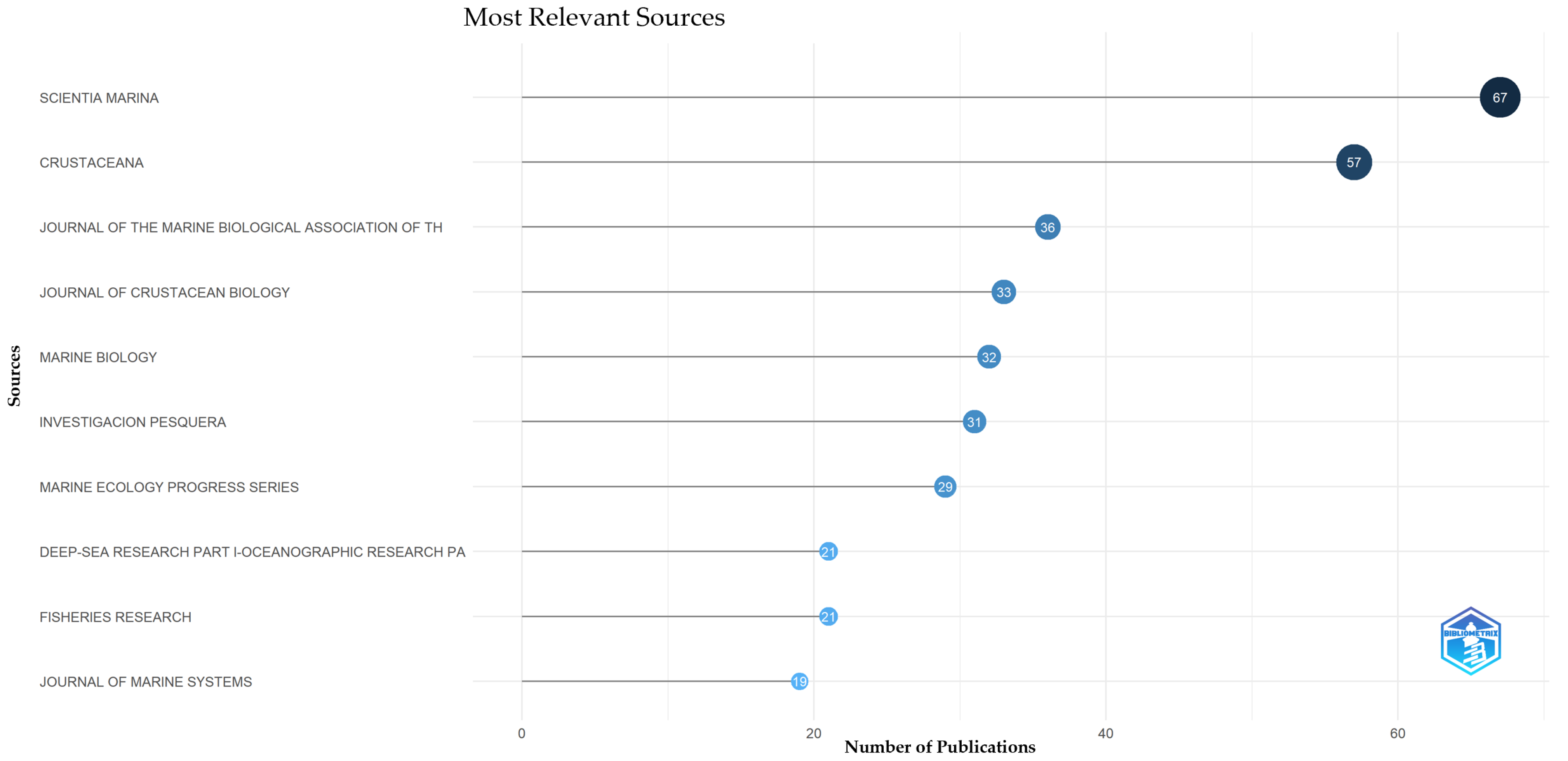
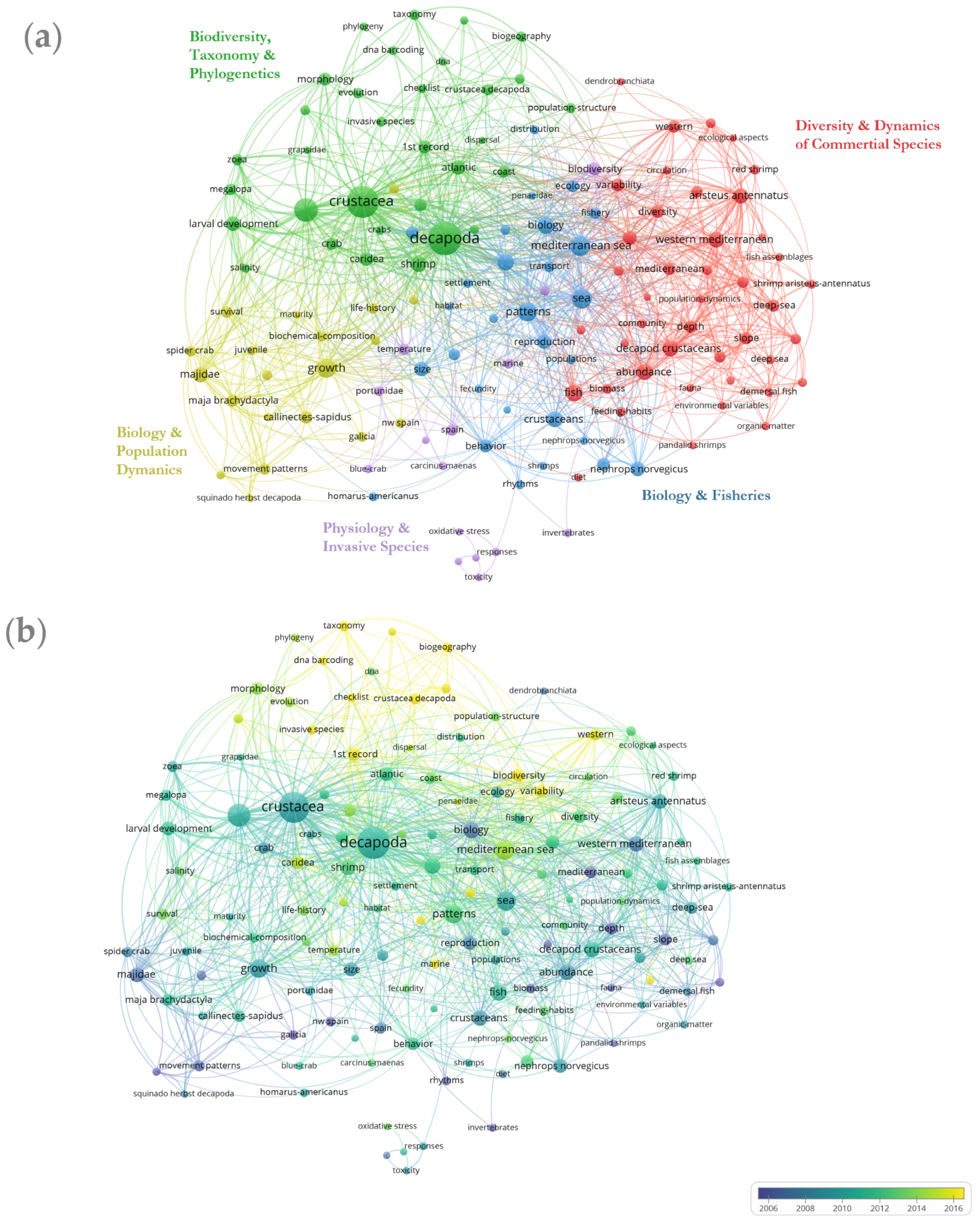
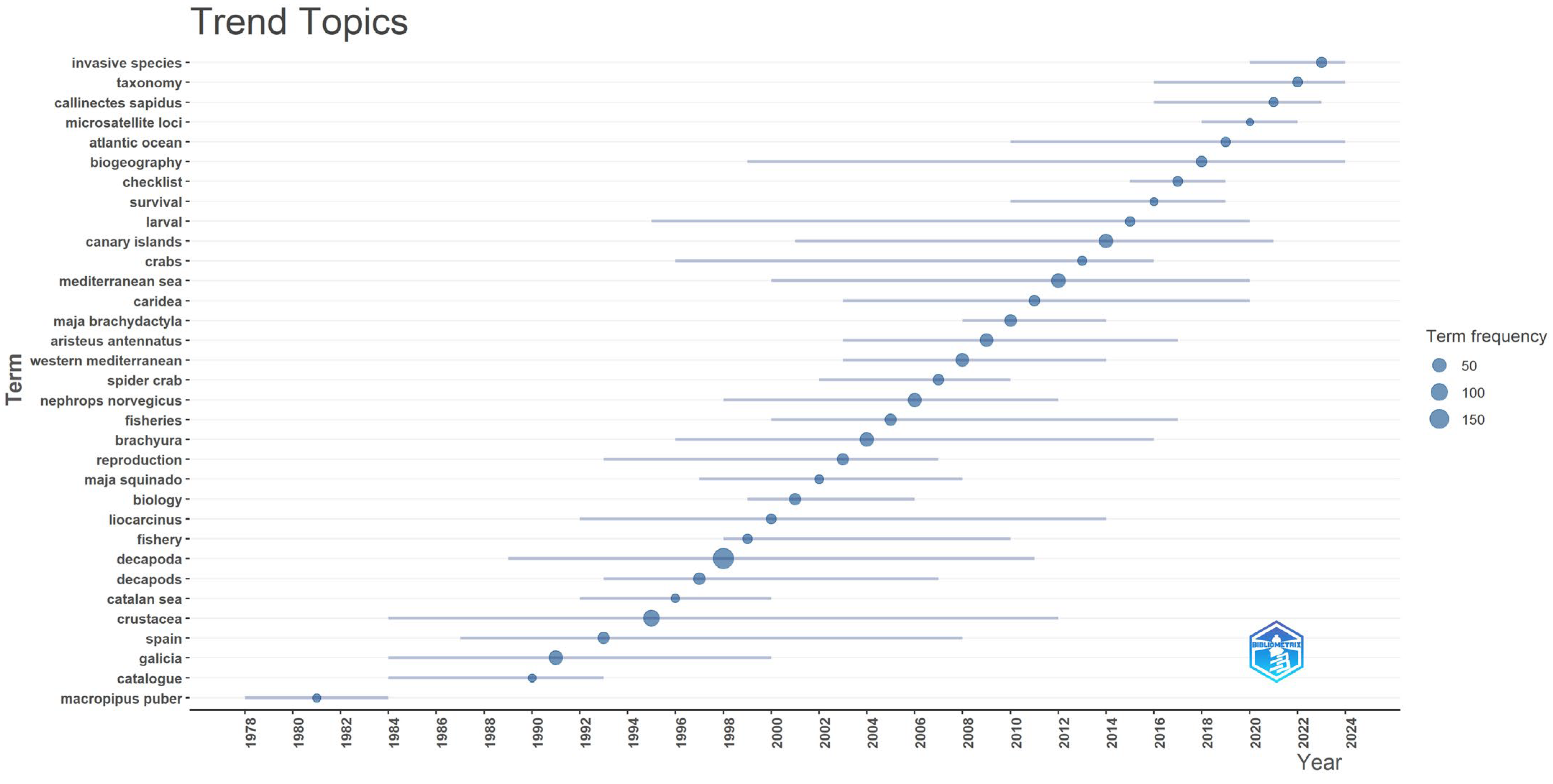
| Publication Type | Number | % Publications |
|---|---|---|
| Article | 873 | 95.6% |
| Book chapter | 6 | 0.6% |
| Review | 34 | 3.7% |
| Authors | Institution | Articles | Total | H Index |
|---|---|---|---|---|
| Abelló, P. | ICM-CSIC | 96 | 132 | 31 |
| Cuesta, J.A. | ICMAN-CSIC | 77 | 286 | 45 |
| Cartes, J.E. | ICM-CSIC | 75 | 183 | 53 |
| Sardà, F. | ICM-CSIC | 75 | 128 | 46 |
| García-Raso, J.E. | U. Málaga | 66 | 50 | 17 |
| Rotllan, G. | ICM-CSIC | 63 | 114 | 27 |
| Guerao, G. | U. Barcelona | 60 | 85 | 19 |
| González-Gurriarán, E. | U. A Coruña | 55 | 40 | 25 |
| González, J.A. | U. Las Palmas | 51 | 132 | 22 |
| Freire, J. | U. A Coruña | 42 | 107 | 36 |
| Aguzzi, J. | ICM-CSIC | 40 | 213 | 40 |
| Maynou, F. | ICM-CSIC | 33 | 177 | 44 |
| Country | Articles | Country | Articles |
|---|---|---|---|
| Portugal | 51 | France | 7 |
| Italy | 27 | Mexico | 7 |
| Germany | 22 | Australia | 5 |
| United Kingdom | 15 | Austria | 5 |
| Canada | 12 | Chile | 5 |
| USA | 12 | Ireland | 5 |
| Argentina | 10 | Belgium | 4 |
| Greece | 9 | Norway | 4 |
| Japan | 8 | China | 3 |
| Brazil | 7 | Colombia | 3 |
Disclaimer/Publisher’s Note: The statements, opinions and data contained in all publications are solely those of the individual author(s) and contributor(s) and not of MDPI and/or the editor(s). MDPI and/or the editor(s) disclaim responsibility for any injury to people or property resulting from any ideas, methods, instructions or products referred to in the content. |
© 2025 by the authors. Licensee MDPI, Basel, Switzerland. This article is an open access article distributed under the terms and conditions of the Creative Commons Attribution (CC BY) license (https://creativecommons.org/licenses/by/4.0/).
Share and Cite
Almón, B.; Bañón, R. Research Trends and State of Knowledge of Decapod Crustaceans in Spain: A Bibliometric Analysis. Ecologies 2025, 6, 63. https://doi.org/10.3390/ecologies6030063
Almón B, Bañón R. Research Trends and State of Knowledge of Decapod Crustaceans in Spain: A Bibliometric Analysis. Ecologies. 2025; 6(3):63. https://doi.org/10.3390/ecologies6030063
Chicago/Turabian StyleAlmón, Bruno, and Rafael Bañón. 2025. "Research Trends and State of Knowledge of Decapod Crustaceans in Spain: A Bibliometric Analysis" Ecologies 6, no. 3: 63. https://doi.org/10.3390/ecologies6030063
APA StyleAlmón, B., & Bañón, R. (2025). Research Trends and State of Knowledge of Decapod Crustaceans in Spain: A Bibliometric Analysis. Ecologies, 6(3), 63. https://doi.org/10.3390/ecologies6030063







